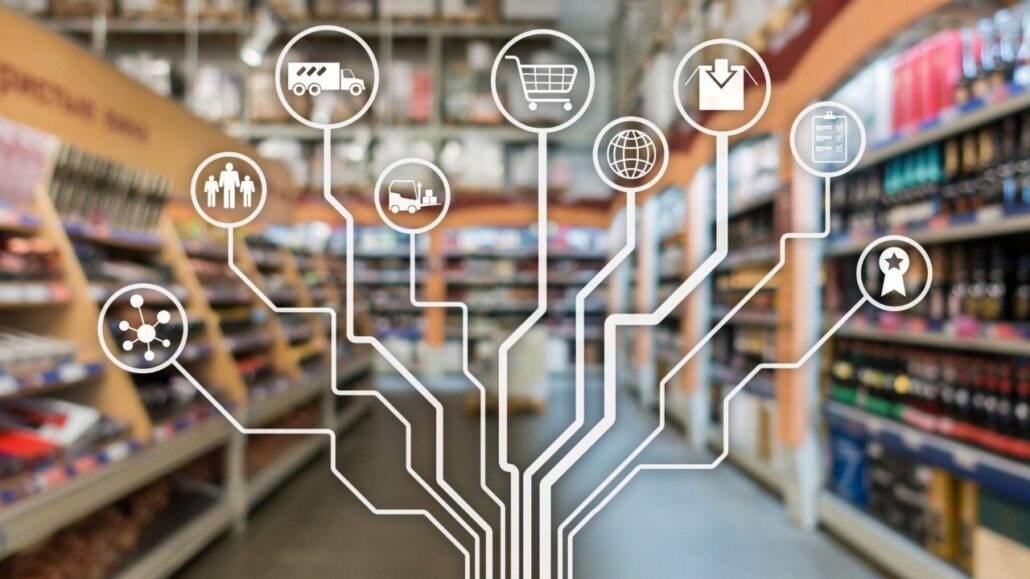Conventional retail stores are engaged in fierce competition with the e-commerce market. While e-commerce offers convenience and a vast product selection, traditional retailers emphasize in-store experiences and personal interactions. To stay competitive, both sides employ strategies like omnichannel approaches, technology integration, and loyalty programs, adapting to evolving consumer preferences and behaviors.
The Retail Terrain Shift
The retail environment has witnessed considerable changes within the last few decades. Conventional retail stores have long been a staple of shopping for countless years, delivering a tangible and all-encompassing experience that captivates our senses.
Strolling through aisles, trying on apparel, and feeling products have always been integral to the customary retail shopping journey. However, the advent of the internet and its accompanying convenience has allowed e-commerce to claim a considerable share of the market.
E-commerce platforms have revolutionized consumers’ shopping patterns. With only a couple of clicks, customers can easily peruse a wide variety of goods and services, finalize transactions from their own homes, and receive their orders at their doorsteps. The irresistible combination of convenience, competitive prices, and a continually expanding product selection has fueled the e-commerce industry’s growth.
Advantages of Conventional Retail

Despite encountering fierce rivalry from e-commerce, traditional retail outlets persist in providing unique benefits that take work to emulate online. These advantages contribute to maintaining their position in the marketplace.
Tangible Experience
Physical shops offer a palpable encounter that e-commerce is unable to reproduce. Customers can closely inspect items, evaluate their quality, and gain an immediate understanding of what they are purchasing. This factor is especially crucial for product categories such as apparel, furniture, and electronic devices.
Personal Engagement
Sales associates supply tailored support by aiding customers in locating suitable products and addressing any inquiries they may have. Personal interactions can elevate the shopping experience while fostering trust between consumers and the brand.
Immediate Gratification
For those unable or unwilling to wait for deliveries, in-person stores fill the void by offering instant fulfillment. Shoppers can enter a store, make a purchase, and leave with their new acquisition on the same day.
Test Prior to Purchase
Traditional outlets afford patrons the opportunity to try on outfits, experiment with electronic devices, or even sample food before finalizing their decisions. This tactile experience acts as a unique selling proposition for brick-and-mortar retailers.
Effortless Returns and Exchanges
The return or exchange process is frequently more straightforward in physical stores. Without the added burden of shipping items back, consumers can efficiently address any concerns regarding their acquisitions.
The Benefits of E-Commerce
E-commerce has experienced substantial growth and popularity due to a host of compelling advantages it offers.
Ease of Use
Among its many merits, e-commerce’s convenience stands out. Consumers can browse a vast array of products anytime, anywhere, using their mobile devices or computers. This feature has been life-changing for those with busy schedules or reduced mobility.
Price Comparisons
E-commerce enables buyers to examine prices on numerous websites easily, ensuring they obtain the most favorable deals. Transparent pricing allows customers to make well-informed purchasing decisions.
Product Variety
Online shopping platforms offer a wider product selection in comparison to most physical stores. Shoppers can discover uncommon items and distinctive goods that may not be accessible locally.
Global Access
E-commerce eliminates geographic restrictions, enabling customers to acquire products from across the globe. Such accessibility broadens the market for both purchasers and merchants.
Feedback and Ratings
Internet-based shoppers can take advantage of other customers’ experiences by perusing product reviews and ratings. These peer insights assist them in making more educated decisions.
Strategic Showdown
The rivalry between conventional retail and e-commerce is an ongoing, dynamic battle. Each sector has made strategic adaptations to remain competitive within the modern marketplace.
Omnichannel Commerce
Many traditional retailers have adopted an omnichannel approach by integrating physical stores with online platforms. This tactic allows them to appeal to a larger audience while offering multiple shopping alternatives.
For example, clients can order items online and collect them in-store or return internet purchases at a physical location. Such strategies blur the boundaries between e-commerce and conventional retail, delivering an uninterrupted shopping experience.
Advanced In-Store Solutions
Physical retailers have employed various technologies to enrich customers’ shopping experiences. Features such as self-checkout kiosks, interactive displays, and augmented reality applications encourage patrons to interact with items in new ways. These tech-savvy innovations help bridge any disconnect between virtual and physical shopping.
Data-Driven Decisions
E-commerce sites excel in data analysis, using client information to tailor marketing efforts, recommend products, and enhance users’ overall experience. Traditional retailers are also tapping into the potential of big data to develop a deeper understanding of their clientele, which results in more effective promotional strategies, product offerings, and inventory control.
Subscription Models
Online-based stores have successfully launched subscription services that regularly deliver goods. Responding to this trend, conventional retailers have similarly introduced subscription options that feature loyalty programs and exclusive benefits designed to compete with the convenience of online subscriptions.
Reward Schemes and Customer Loyalty Initiatives
To maintain and draw in clientele, both traditional brick-and-mortar stores and online retailers implement reward schemes and customer loyalty initiatives. Such programs may encompass special deals, exclusive offers, and various rewards, all aimed at fostering a dedicated client base that consistently returns.
Obstacles and Dangers
Different retail channels are confronted with distinctive hurdles that can impact their ability to compete successfully within the marketplace.
Challenges for Brick-and-Mortar Retail
Elevated Operational Expenses
Operating physical locations, renting properties, and employing a substantial workforce can contribute to greater costs for conventional retailers.
Rivalry with Online Commerce
Traditional retail businesses encounter head-on competition from e-commerce platforms, which commonly have reduced prices due to decreased overhead expenses.
Shifting Shopper Habits
Consumer preferences are continuously changing, with more individuals leaning toward the convenience offered by online shopping. To stay pertinent, traditional establishments must adapt accordingly.
Stock Management
Ensuring appropriate inventory in physical shops can be quite difficult; unsold products consume capital and lead to storage expenses.
Challenges for Online Retail
Delivery and Shipping Expenses
E-commerce businesses need to invest in storage facilities, shipping, and logistics, which can be costly and complex to manage.
Customer Confidence
Establishing and preserving trust in an online setting is of utmost importance. Factors such as security breaches or counterfeit items threaten this trust.
Product Returns and Exchanges
Managing product returns and exchanges for e-commerce can take time and effort, resulting in increased operational costs and potential customer displeasure.
Competition and Market Saturation
Gaining a foothold in the intensely competitive e-commerce industry is challenging for newcomers. Similarly, established enterprises have to constantly innovate to stay ahead of their rivals.
Customer Behavior
Grasping the changes in consumer habits, along with their ongoing evolution, is vital to creating effective strategies for both brick-and-mortar retail stores and e-commerce platforms.
Efficiency and Promptness
Consumers increasingly seek time-saving solutions and readily available products. Online shopping offers the height of convenience, including shopping from various locations and expedited deliveries. To stay competitive, traditional retailers must also strive to create efficient and convenient shopping experiences.
Showrooming
This occurs when shoppers visit physical stores to inspect items firsthand before making online purchases at more competitive prices. Conventional retailers should address this by offering unique in-store experiences and price matching.
Brand Allegiance

Developing brand allegiance is essential for both brick-and-mortar and online retail stores. By resonating with consumers and providing exceptional customer support, businesses are more likely to retain customers in such a cutthroat market.
Digital Reviews and Suggestions
Digital evaluations and endorsements sway the choices of customers. Both brick-and-mortar stores and e-commerce businesses must proactively maintain their online presence and engage with consumer opinions.
Conclusion
Retail Stores Competing With The E-Commerce Market, The rivalry between traditional retailers and the e-commerce sector is intense, with both channels possessing distinct strengths and difficulties. Even though e-commerce has made remarkable progress, conventional retail thrives by offering physical shopping experiences, face-to-face interactions, and immediate satisfaction.
To keep up with the competition, traditional retailers implement tactics that utilize technology, improve data-driven analyses, and incorporate omnichannel commerce. Meanwhile, e-commerce maintains its growth by delivering convenience, a wide range of products, and transparent pricing. The primary factors contributing to success in this domain include:
- Establishing and retaining customer confidence.
- Managing order fulfillment effectively.
- Adjusting to changing shopper habits.
FAQ:
Are Conventional Retail Stores Adapting to the E-Commerce Challenge?
Yes, many conventional retail stores are adapting to compete with the e-commerce market by integrating online and offline strategies.
What Advantages Do E-Commerce Platforms Have Over Conventional Retail Stores?
E-commerce platforms offer advantages such as convenience, extensive product selection, and price transparency.
How Can Conventional Retail Stores Enhance the In-Store Experience to Compete With E-Commerce?
Conventional retail stores can enhance the in-store experience through technology, personalized services, and interactive displays.
Do Consumers Prefer Online Shopping Over Traditional Retail?
Consumer preferences vary, but many prefer online shopping for its convenience, especially for routine or time-sensitive purchases.
What Strategies Are Conventional Retailers Using to Bridge the Gap with E-Commerce?
Conventional retailers are using strategies like omnichannel retailing, data-driven insights, and loyalty programs to bridge the gap.
Are E-Commerce Returns More Challenging for Retailers Than In-Store Returns?
E-commerce returns can be more logistically challenging and costly for retailers due to shipping and handling.
Is Showrooming a Significant Challenge for Conventional Retail Stores?
Showrooming, where customers view products in-store and purchase online, is a challenge, but retailers can address it through competitive pricing and unique in-store experiences.
How Are Conventional Retailers Utilizing Technology to Compete with E-Commerce?
Retail Stores Competing With The E-Commerce Market, Conventional retailers are integrating technology like self-checkout kiosks, augmented reality, and online inventory management to enhance the shopping experience.
Do E-Commerce Platforms Struggle with Building and Maintaining Customer Trust?
Retail Stores Competing With The E-Commerce Market, Building and maintaining customer trust is a concern for e-commerce platforms, particularly in terms of data security and product authenticity.
What Role Does Brand Loyalty Play in the Retail Competition Between Conventional and E-commerce?
Retail Stores Competing With The E-Commerce Market, Brand loyalty is crucial for both retail channels, as brands that resonate with consumers and provide excellent service are more likely to retain customers.



